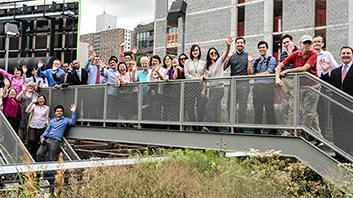Happy Chuseok!
As the seasons change and Autumn is upon us, Unificationists observe the Korean harvest holiday, Chuseok, or the “Korean Thanksgiving”. The national headquarters team wishes you and your family a Happy Chuseok and an overview of the holiday.
Chuseok is one of the most celebrated holidays in modern Korea. True Parents celebrate Chuseok every year and have made it an international Unificationist tradition. For individuals unfamiliar with the holiday, also known as the “Korean Thanksgiving,” here is an overview.
This major harvest festival, also called Hangawi, Jungchujul or Gabe, is a three-day holiday in Korea celebrated on the 15th day of the 8th month of the lunar calendar. Koreans still follow the moon and its cycle to celebrate important dates. Like many other harvest festivals, Chuseok is held around the autumn equinox. As a celebration of the good harvest for the grains and fruits which are at their ripest and freshest for harvesting, Koreans visit their ancestral hometowns and share a feast of Korean traditional food and rice wines. This year it was celebrated today, September 8, 2014. The next Chuseok will be celebrated on September 26, 2015.
Its beginnings originate both in folklore and in common belief. Some think Chuseok originates from gabae, a month-long weaving contest between two teams that started during the reign of the third king of the Silla dynasty (57 BC – 935 AD). The team that had woven more cloth won and was treated to a feast by the losing team. Others believe it marks the day that Silla won a great victory over the rival kingdom of Baekje. It is believed that weaving competitions, archery competitions and martial arts demonstrations were held as part of the festivities.Many scholars believe it may originate from ancient shamanistic celebrations of the harvest moon.New harvests are offered to local deities and ancestors, giving Chuseok its origins as a worship ritual. However, the origins of Chuseok are less important than what it represents.
In Korean culture, heavily influenced by Confucianism, respect for the elderly is extremely important. Thus Chuseok is not simply a feast celebration like the American holiday of Thanksgiving. For Chuseok, people must complete three major duties:
Charye (ancestor memorial service): On Chuseok morning, family members prepare an elaborate table setting of food in their home to pay respect to their respective ancestors. The important food offering for Charye is freshly harvested rice, an assortment of fruits, alcohol and songpyeon (half-moon shaped rice cakes): The harvest crops are attributed to the ancestors. There are meticulous steps setting up the offering table, including lighting candles before the alcohol is poured in exactly three different cups and bowing twice afterward. Each dish also has a specific area of the table it needs to go on. The meaning of Charye is to return the ancestors’ favors and honor them. After paying respects, the family members will sit around the table and enjoy the food together.
Beolcho (clearing weeds around graves): The custom of clearing the weeds from the ancestors’ resting places is considered a duty and expression of devotion and respect for one’s family. If the resting places still have weeds growing around them after Chuseok, it will make others assume that the ancestors have undutiful children, and is considered an embarrassment for a family.
Seongmyo (visiting ancestral graves): Koreans visit the resting places of their ancestors, usually at the families’ respective hometowns, and must pay respect to the grave and perform ancestral worship rituals, often in the form of bowing before the grave and offering alcohol, fruits, meat and shikhye (fermented rice drink).
Once these tasks are completed, it is time to feast and chat and drink after dinner and play traditional and modern Korean games.
As part of the Chuseok celebrations, Korean leaders from the Family Federation for World Peace and Unification (FFWPU) Korea pay their respects at the resting site for members of True Parents’ family at Paju Mountain, 25 miles north of Seoul and 1.5 hours from Cheongpyeong. At Paju there are two wonjeon (resting places). One is for the True Parents’ family and the other is for the elder Unificationists.
Tasty Fact:
Songpyeon
One of the major foods prepared and eaten during Chuseok is a Korean traditional rice cake stuffed with healthy ingredients such as sesame seeds, black beans, mung beans, cinnamon, pine nut, walnut, chestnut, jujube and honey. The rice cake, Songpyeon, is made up of two halves of rice skin which, when put together, resemble a full moon. Once it’s filled with stuffing, however, its shape resembles a half moon. Ever since the Three Kingdoms era in Korean history, there has been a Korean legend that says these two shapes ruled the destinies of the two greatest rival kingdoms, Baekje and Silla. During the era of King Uija of Baekje, an encrypted phrase, “Baekje is full moon and Silla is half moon,” was found on a turtle’s back, and it was believed to have predicted the fall of the Baekje and the rise of the Silla. The prophecy came true when Silla defeated Baekje in war. Ever since, Koreans started to refer to a half-moon shape as the indicator of a bright future or victory. Therefore, during Chuseok families gather together and eat half-moon shaped Songpyeon under the full moon, wishing themselves a brighter future.
Have a Happy Chuseok!

